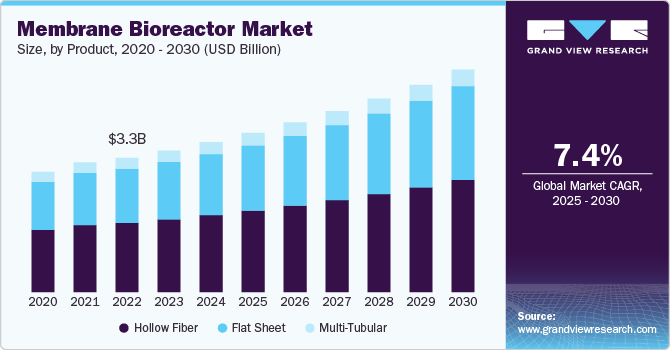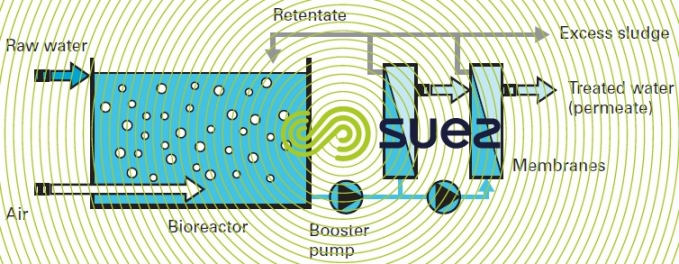Membrane Bioreactors Explained: Effective Solutions for Tidy Water
Membrane bioreactors (MBRs) have actually emerged as an advanced solution for resolving the pressing obstacles of wastewater treatment - Membrane Bioreactor. By incorporating biological procedures with innovative membrane filtration, MBRs not just boost the quality of treated water yet likewise lower the spatial requirements of therapy centers.

What Are Membrane Layer Bioreactors?
Membrane layer bioreactors (MBRs) are sophisticated wastewater treatment systems that incorporate organic destruction procedures with membrane filtration technology. This assimilation permits for the reliable removal of pollutants from water, making MBRs a preferred selection in numerous applications, including municipal wastewater therapy and industrial effluent management.

Among the crucial advantages of MBRs is their ability to generate top quality effluent, usually appropriate for reuse in irrigation or industrial processes. Furthermore, MBRs need a smaller sized impact contrasted to standard therapy systems, making them ideal for urban settings where space may be limited.
Furthermore, MBRs can efficiently handle differing influent loads and are less susceptible to the effects of hazardous shocks. These attributes add to their growing popularity as a sustainable solution for addressing the increasing need for tidy water while lessening ecological effects.
Exactly How Membrane Bioreactors Job
While the procedure of membrane layer bioreactors (MBRs) may seem facility, it basically rotates around the synergy between organic procedures and membrane layer filtering. MBRs integrate an organic treatment process, normally turned on sludge, with a membrane layer splitting up device to deal with wastewater successfully.
In an MBR system, wastewater is very first presented right into a bioreactor where microbes deteriorate organic issue and other impurities. The organic activity lowers the concentration of pollutants while advertising the growth of biomass. Following this organic treatment, the combined liquor goes through membrane layer filtering, which can be microfiltration or ultrafiltration, depending on the wanted effluent quality.
The membrane layers function as a physical barrier, enabling water and small solutes to pass while maintaining suspended solids and larger molecules. This makes it possible for the system to preserve a high focus of biomass within the reactor, improving the treatment effectiveness.
Furthermore, the continual splitting up of treated water from the biomass promotes a small layout and reduces the impact of the therapy facility. Generally, the combination of biological deterioration and membrane layer filtration in MBRs leads to effective and reliable wastewater therapy, ensuring top quality effluent appropriate for different applications.
Advantages of MBR Technology
One of the crucial benefits of membrane bioreactor (MBR) technology is its capability to create high-grade effluent with a dramatically reduced footprint compared to standard wastewater therapy methods. MBR systems efficiently combine biological therapy and membrane layer filtration, resulting in exceptional removal of contaminants, including suspended solids, pathogens, and natural issue. This capacity brings about effluent that usually fulfills or goes beyond rigorous governing requirements for reuse and discharge.
Furthermore, MBR innovation permits higher biomass focus, which improves the helpful hints treatment efficiency and reduces the called for activator volume. This compact layout is specifically advantageous in urban locations Our site where room is restricted. The operational adaptability of MBR systems additionally indicates they can adjust to differing influent top qualities and circulation rates, making them suitable for a vast array of applications.
In addition, the minimized sludge production linked with MBR processes contributes to reduce operational and upkeep costs. The membrane layers act as a physical obstacle, lessening the risk of obstructing and allowing longer operational periods in between cleaning. On the whole, the advantages of MBR modern technology make it an appealing solution for lasting wastewater treatment, attending to both environmental worries and the need for reliable resource administration.
Applications of Membrane Bioreactors
With their flexibility and performance, membrane bioreactors (MBRs) discover applications throughout various markets, consisting of community wastewater therapy, commercial processes, and even water improvement. In metropolitan settings, MBRs offer a portable solution for treating wastewater, successfully removing pollutants while simultaneously producing high-grade effluent that satisfies rigid regulative criteria. This makes them specifically suitable for areas with restricted area.
In commercial applications, MBR modern technology is utilized for dealing with process water, particularly in markets such as food and beverage, pharmaceuticals, and petrochemicals. These markets profit from MBRs' capability to take care of high natural lots and their performance in recouping beneficial sources from wastewater, such as nutrients and water.
Moreover, MBRs play an essential function in water improvement efforts, allowing the reuse of treated wastewater for irrigation, industrial procedures, and even as safe and clean water after more therapy (Membrane Bioreactor). Their effectiveness in eliminating toxins and virus makes them a reliable selection for making certain water top quality in different reuse applications
Future of Water Treatment Solutions
The future of water treatment remedies is positioned for transformative developments driven by technological development and increasing ecological understanding. As worldwide water deficiency becomes a pressing issue, new approaches, consisting of membrane layer bioreactor (MBR) systems, are imp source readied to play a crucial function in enhancing the performance and sustainability of water treatment procedures.
Emerging technologies such as expert system and equipment discovering are expected to enhance treatment procedures, enabling for real-time surveillance and predictive upkeep. This will boost the general integrity and efficiency of water therapy facilities. Improvements in membrane materials, such as graphene and nanofiltration, guarantee to raise permeation rates and minimize fouling, leading to reduced power consumption and operational expenses.
In addition, the assimilation of eco-friendly power sources into water treatment plants will certainly add to greener techniques. The circular economy model will certainly additionally obtain grip, motivating the recovery of valuable resources from wastewater, such as nutrients and energy.
Conclusion

Membrane bioreactors (MBRs) have emerged as an advanced option for resolving the pushing challenges of wastewater treatment. By integrating biological processes with advanced membrane layer filtering, MBRs not only enhance the high quality of treated water however likewise decrease the spatial demands of treatment facilities.One of the essential advantages of membrane bioreactor (MBR) technology is its ability to produce top quality effluent with a substantially minimized footprint compared to conventional wastewater therapy approaches.With their convenience and performance, membrane bioreactors (MBRs) discover applications throughout various sectors, consisting of metropolitan wastewater therapy, industrial processes, and even water recovery.In final thought, membrane bioreactors represent a substantial improvement in wastewater treatment technology, incorporating biological processes with reliable membrane purification to create premium effluent.